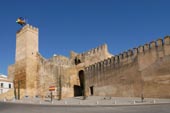A city with a population of around 700,000, Seville is one of the most important cities in southern Spain. Artistically, financially and culturally it is the hub of the region of Andalucia and is one of the most visited cities in Spain. Lying in the plain of the Guadalquivir river, Seville covers an area of 140 square kilometres and has a metropolitan population around double of that of the city itself. Historically, Seville is over two thousand years old and was called Hispalis during the Roman occupation of the Iberian Peninsular. There are still Roman remains to be found in and around Seville, one of the best known being the aqueduct. Following the collapse of the Roman Empire, Seville fell successively into the hands of Vandal, Visigoths and Moors, but it was the Moors who had the greatest influence on the city, and it became a significant centre under the control of the Umayyad dynasty. It came back under Christian control in the mid-13th century. These days Seville is a popular tourist destination with plenty to see and do all year round, although as Seville weather can be extremely hot during July and August, these months are perhaps best avoided if possible. Among the best known attractions in the city are the cathedral, built between 1401 and 1519, the Alcazar, begun in the 12th century, the Torre del Oro (Golden Tower), the Town Hall, and the Plaza de Espana. Outside the city of Seville itself are some other interesting places to visit, one you could consider might be the town of Utrera, one of the main agricultural towns of the region and the area where many of the bulls, reared especially for bullfighting are bred and tended. Utrera was overrun by Alfonso X in the 13th century, as he prepared for his defeat of Seville. Worth a look in Utrera are the 14th century castle, the Iglesia de Santiago church and the church of Santa Maria. Seville Map.
